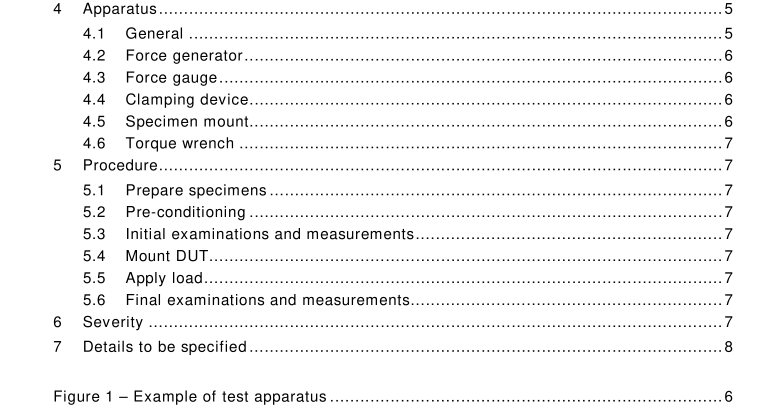IEC 61300-2-6:2010 pdf download – Fibre optic interconnecting devices and passive components – Basic test and measurement procedures – Part 2-6: Tests – Tensile strength of coupling mechanism
1 scope
This part of lEC 61300 describes a test to ensure that the coupling mechanism of aconnector set or connector and device combination will withstand the axial loads likely to beapplied during normal service.
Normative references
The following referenced documents are indispensable for the application of this document.For dated references,only the edition cited applies. For undated references, the latestedition of the referenced document (including any amendments) applies.
IEC 61300-1,Fibre optic interconnecting devices and passive components – Basic test andmeasurement procedures – Part 1 : General and guidance
IEC 61300-3-1,Fibre optic interconnecting devices and passive components – Basic testand measurement procedures – Part 3-1: Examinations and measurements – Visualexamination
IEC 61753-1,Fibre optic interconnecting devices and passive components performancestandard -Part 1 : General and guidance for performance standards
3General
Atensile load is smoothly applied to a mated connector set or connector and devicecombination in a direction that will separate the components. The load is normally appliedbetween the connector plug and the adapter or between the connector plug and the devicebeing tested.
4Apparatus
4.1General
The test apparatus shall be capable of applying an axial load between a connector plug orcoupling mechanism and an adapter or device.An example of a test apparatus is shown inFigure 1.Some or all of the following apparatus components will be required.
4.2 Force generator
The force generator may be any device or apparatus capable of smoothly applying the specified force at the specified rate.
4.3 Force gauge
A force gauge of specified accuracy shall be used to measure the axial force applied to the device under test (DUT).
4.4 Clamping device
A suitable clamping device shall be used to couple the force generator to the connector plug or coupling mechanism. Care shall be taken in the design and use of the clamping device to ensure that it does not apply compressive forces which might influence the performance of the connector plug or coupling mechanism.
4.5 Specimen mount
Mount the specimen according to normal mounting procedures.
4.6Torque wrench
A torque wrench may be required to assemble screw type connectors in accordance with themanufacturer’s instructions.
5Procedure
5.1 Prepare specimens
Mate the specimens according to the manufacturer’s instructions.For screw type couplings,use a torque wrench to ensure that the couplings are tightened to the proper value.
5.2Pre-conditioning
Unless otherwise specified,pre-condition each prepared specimen for 2 h at the standardtest conditions specified in lEc 61300-1.
5.3lnitial examinations and measurements
Complete initial examinations and measurements on the specimen shall be made asrequired by the relevant specification. Visual examination shall be done according tolEC 6130o-3-1.
5.4Mount DUT
Securely mount one part of the DUT, usually the connector adapter,switch,attenuator,etc.to the stationary portion of the test fixture. Fix the other part of the device under test,usually the connector plug or coupling mechanism,to the ‘movable portion of the forcegenerator.
5.5Apply load
Smoothly apply the tensile load, as recommended in Table 1 or the specified rate, up to thespecified value and specified duration.
5.6Final examinations and measurements
Remove the tensile load from the specimen and the specimen from the test mounting.Unless otherwise specified,visually examine the specimen and its component parts inaccordance with lEC 61300-3-1.Check for evidence of cracking,permanent deformation orother damage which might impair its function,and against any other pass/fail criteriaspecified in the relevant specification.
6 Severity
The severity of the test is dependant upon the magnitude of the tensile load and to a lesserextent to the rate of application and duration of the load.The magnitude, rate of applicationand duration of the load shall be given in the relevant specification.Recommended valuesof the test parameters are given in Table 1.
7 Details to be specified
The following details, as applicable, shall be given in the relevant specification:
– magnitude and rate of application of the tensile load;
– coupling torque prior to testing, if necessary;
– fibre type and length;
– pre-conditioning procedure;
– recovery procedure;
– optically functioning or non-functioning;
– initial examinations and measurements and performance requirements;
– examinations and measurements during test and performance requirements, if required;
– final examinations and measurements and performance requirements;
– optical measurement method, if necessary;
– deviations from the test procedure;
– additional pass/fail criteria.
